
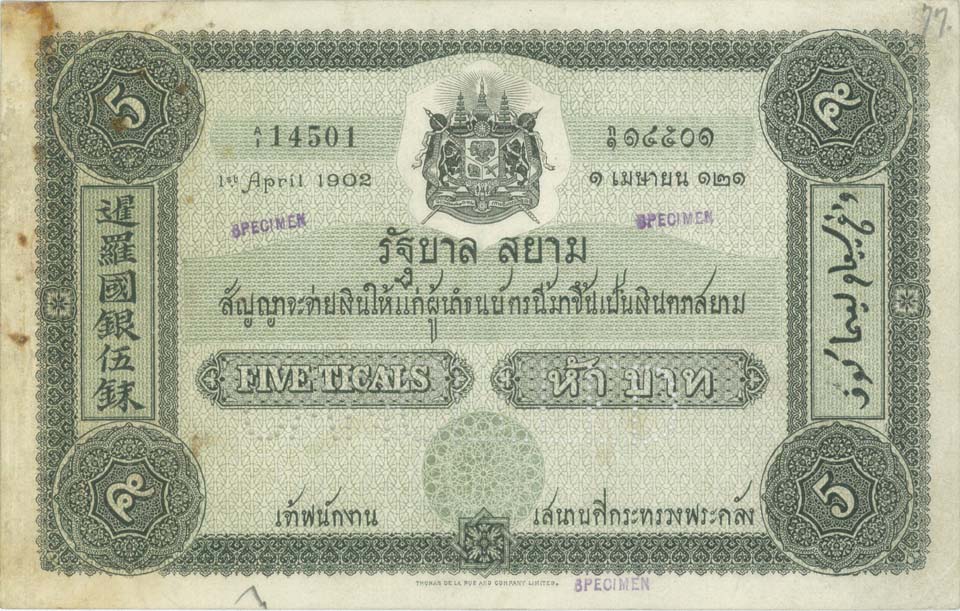
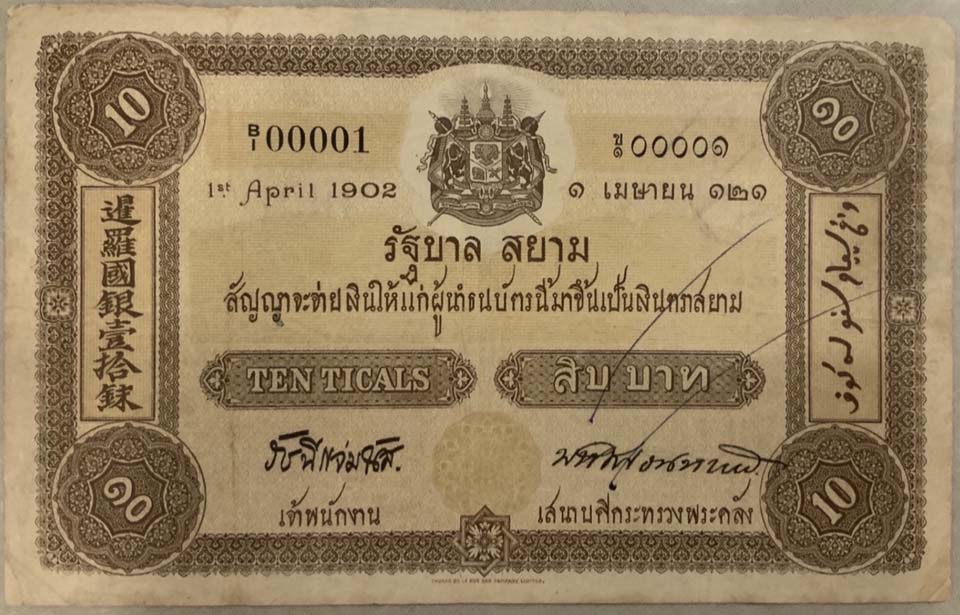
The First Series of Thai Banknotes were announced on September 7, 1902. There were five denominations, 5-Baht, 10-Baht, 20-Baht, 100-Baht and 1000-Baht.
The notes had alphabetical code and serial numbers in two places, in Thai and also a Roman alphabetical code and Arabic serial numbers.
During 1910 to 1915 changes were made whereby the alphabetical codes and serial numbers on the notes were increased from two to four places. I asked collectors, dealers and the Bank of Thailand for the reason for the change, but no one could enlighten me.
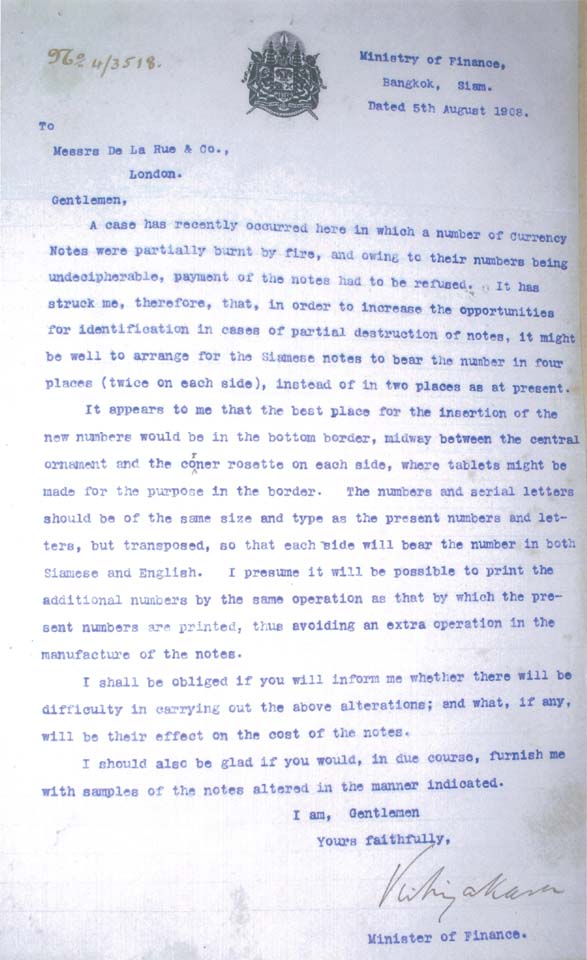
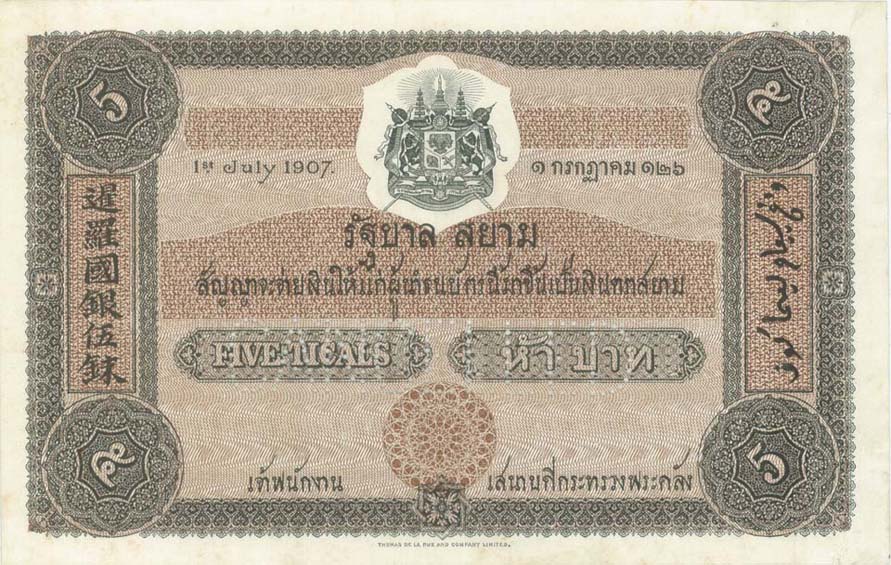
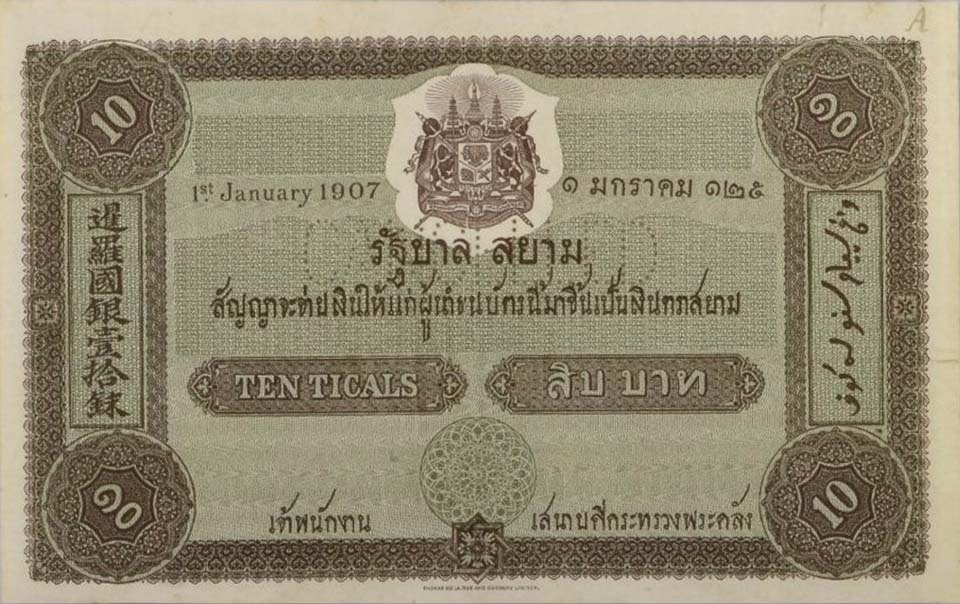
I found the answer to the mystery in the archives of Thomas de la Rue & Company Limited, London (TdlR), the producer of the Thai Banknotes. The Minister of the Royal Finance H.R.H. Prince Kitiyakara showed great interest in the banknotes. On the 5th of August 1908 he sent a letter to TdlR. In the letter the Minister writes: “A case has recently occurred here which a number of currency Notes were partially burnt by fire, and owing to their numbers being undecipherable, payment of the notes had to be refused”.

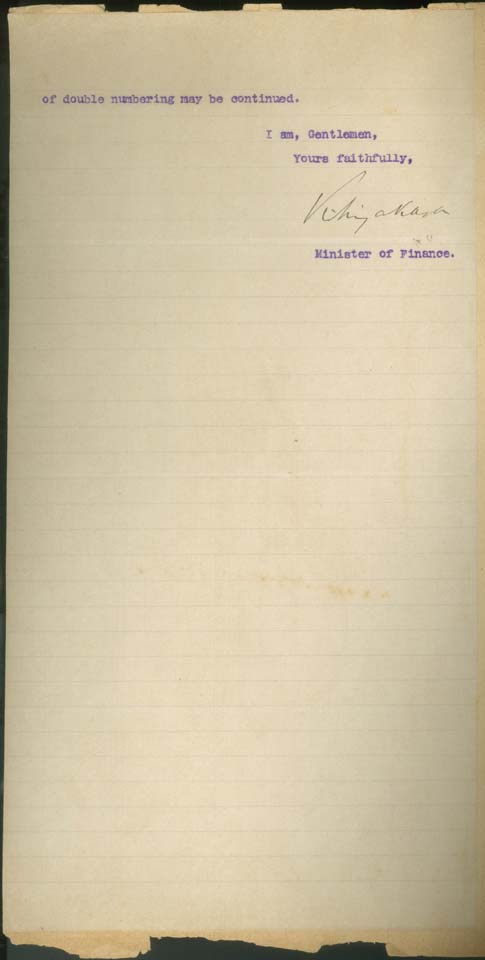 The Minister therefore suggests that instead of numbers in two places there should be numbers in four places. The new numbers and serial letters should be inserted in the bottom border and asks TdlR to furnish samples of the notes altered in the manner indicated.
The Minister therefore suggests that instead of numbers in two places there should be numbers in four places. The new numbers and serial letters should be inserted in the bottom border and asks TdlR to furnish samples of the notes altered in the manner indicated.

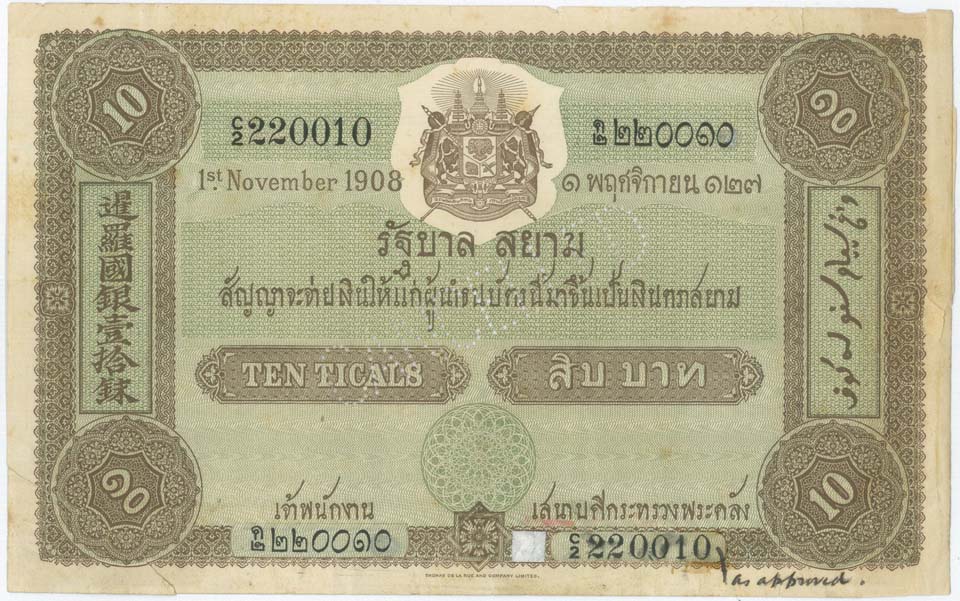 On the 23rd of September 1908, TdlR forwarded a 5-Baht and a 10-Baht note showing the manner in which TdlR proposed to carry out the idea which the Minister suggested with numbers and serial letters in four places instead of two.
On the 23rd of September 1908, TdlR forwarded a 5-Baht and a 10-Baht note showing the manner in which TdlR proposed to carry out the idea which the Minister suggested with numbers and serial letters in four places instead of two.
The Minister approved generally in a letter of the 19th of December 1908 the method adopted by TdlR. The Minister asked TdlR to arrange that the numbers and serial letters be within the coloured border at the bottom of the note. He marked this with a piece of paper glued on the panel to illustrate what he meant. New proofs showing this were to be produced.
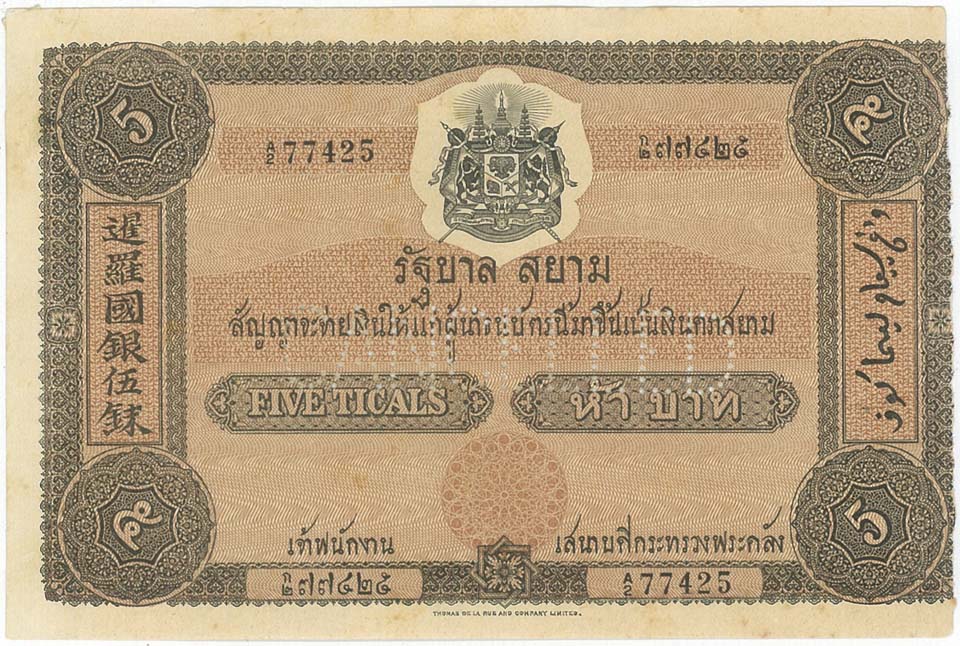
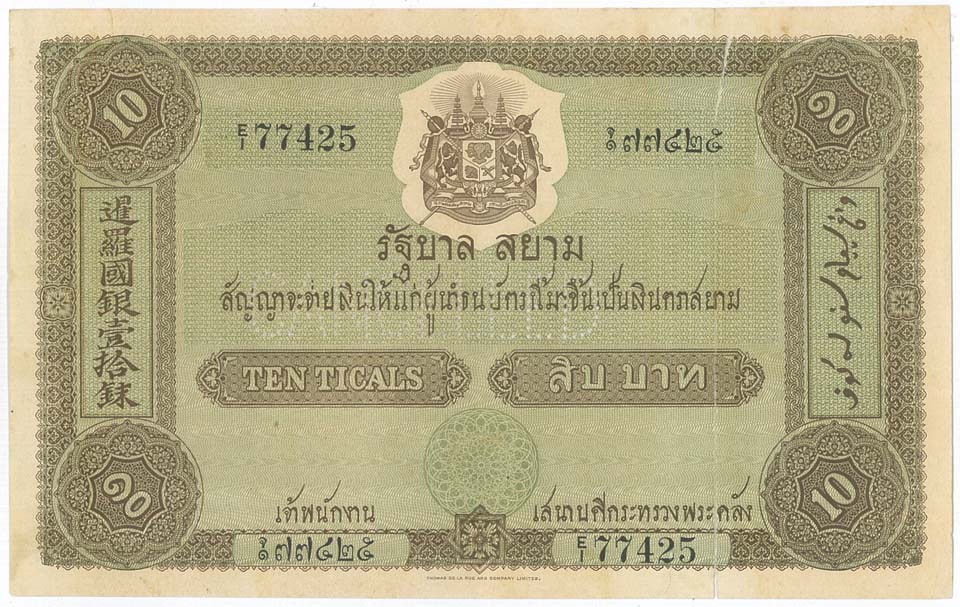 On 4th February 1909, TdlR sent the cancelled specimens of the currency notes with an additional set of numbers shown in the lower border for approval. It was mentioned by TdlR that the space on the border where the numbers were to be registered was very close. Occasionally the numbers might impinge slightly on the border. The Minister therefore had the opinion that the lower border should be untouched also because it would spoil the appearance of the notes. The Minister asked TdlR to furnish proposed new designs. He would also like to know the cost of engraving fresh plates for the five denominations notes.
On 4th February 1909, TdlR sent the cancelled specimens of the currency notes with an additional set of numbers shown in the lower border for approval. It was mentioned by TdlR that the space on the border where the numbers were to be registered was very close. Occasionally the numbers might impinge slightly on the border. The Minister therefore had the opinion that the lower border should be untouched also because it would spoil the appearance of the notes. The Minister asked TdlR to furnish proposed new designs. He would also like to know the cost of engraving fresh plates for the five denominations notes.

 TdlR agreed with the Minister that having the numbers on the lower border on the note would have a makeshift appearance. On the 5th of May 1909 new specimen-notes were sent to the Minister where the new numbers were moved up from the lower border. In doing so, the designations of the officials whose signatures are to be stamped on the notes had been pushed up so high that the stamped signatures would have to be placed below the designations. The Minister asked TdlR to send fresh specimens showing the designations above the numbers. The Minister was of the opinion that it was customary to have the signatures above the designations. TdlR would carry out the alteration without any additional charges.
TdlR agreed with the Minister that having the numbers on the lower border on the note would have a makeshift appearance. On the 5th of May 1909 new specimen-notes were sent to the Minister where the new numbers were moved up from the lower border. In doing so, the designations of the officials whose signatures are to be stamped on the notes had been pushed up so high that the stamped signatures would have to be placed below the designations. The Minister asked TdlR to send fresh specimens showing the designations above the numbers. The Minister was of the opinion that it was customary to have the signatures above the designations. TdlR would carry out the alteration without any additional charges.



A specimen 5 Baht and 10 Baht note was sent to the Thai Minister on the 22nd of July 1909. Here the designations of the officers were printed immediately over the lower numbers. The new designs were approved and on the 20th of September the Minister of the Royal Finance H.R.H. Prince Kitiyakara instructed TdlR that all future supplies of notes should be printed with four sets of numbers.
References:
-The archives of Thomas de la Rue & Company, Limited
-Bank of Thailand, “Centenary of Thai Banknotes: 1902 – 2002”
-Somchai Saeng-ngern, “Thai Banknotes Catalogue, Complete and Updated Edition”
-Thank you to Pratheep S. Malhotra and Bank of Thailand Museum
-All illustrations from Jan Olav Aamlid collection
Copyright© 2020 All rights reserved by Jan Olav Aamlid





